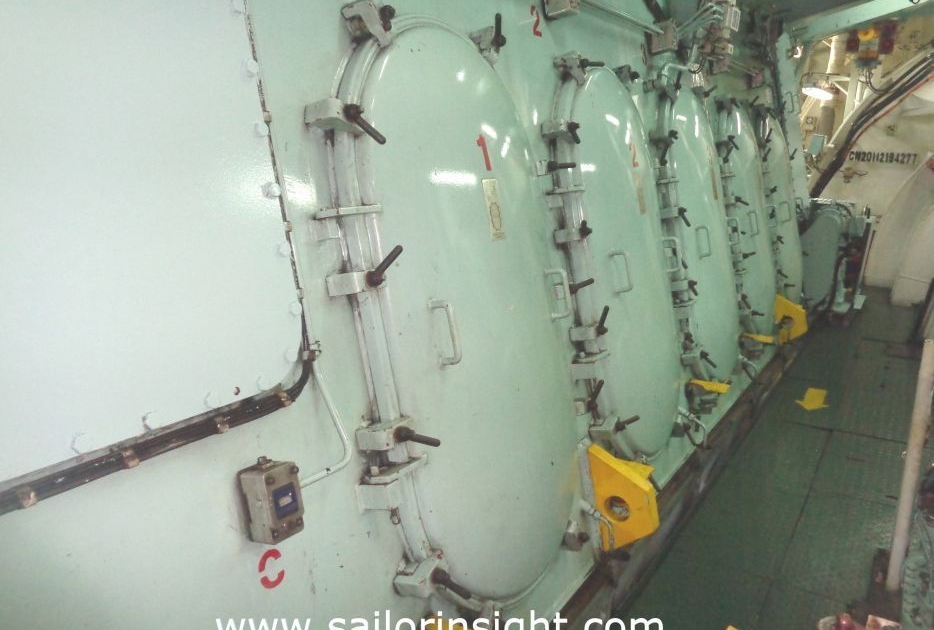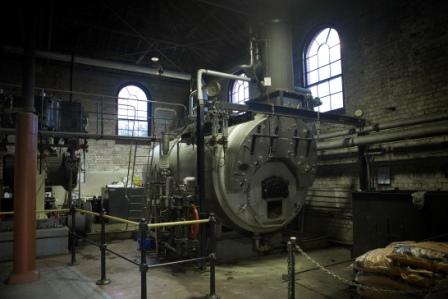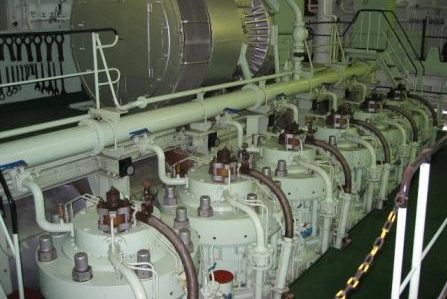Crankcase explosion
Under normal circumstances, the air in the crankcase will contain droplets formed by lubricating oil splashing from the bearings and impinging on moving surfaces. If a hot spot develops and the oil mist reaches a certain concentration, it will be ignited and a primary explosion will occur. For such an explosion a crankcase non-return relief door is provided through which the pressure is released. If this pressure is not released it will cause the casing to rupture causing fresh air to enter into the casing and thus causing a secondary (major) explosion. This secondary explosion is of such intensity that it can cause widespread damage and even cause injury to personnel.
Causes for crankcase explosion
Development of hotspot within the crankcase or adjacent space.
Causes of the hotspot:
1. Overheated bearing due to failure or restriction of lub-oil from choked/blocked lub-oil pipes, low pump pressure, or leakage in the system.
2. Crankshaft misalignment.
3. Piston misalignment causing friction at stuffing box.
4. Rubbing of the part which was never meant to come in contact eg due to a sudden axial load on the crankshaft the crank webs may slide against main bearings.
5. Too slack chain.
6. Scavenge fires.
7. Overloading of the engine.
Detection
Without instruments:
1. Irregular running of an engine, noise from the crankcase.
2. Crankcase door very hot to touch.
3. Smoke/sparks discharging from the crankcase door.
With instruments:
1. The oil mist detector will give an alarm.
2. Temperature sensors in bearing oil return lines give an alarm.
Working of an oil mist detector
The obstruction type oil mist detector consists of two parallel tubes of equal sizes, each having a photoelectric cell at one end which generates an electric current directly proportional to the intensity of light falling on its surface. Lenses are fitted to seal the end of each tube but allow light to pass through. Two identical beams of light are made to pass along the tubes. This light is produced by the same bulb and made to reflect through mirrors.
The samples are drawn using a selector valve. A concentration of oil mist is present in the sample, the light will be obscured in the measuring tube, electrical balance will be disturbed and an alarm will be operated.
Precautions to minimise crankcase explosion
A. Maintenance of parts:
1. Regular overhauling and inspection of bearings.
2. Regular overhauling of the stuffing box.
3. Regular crankcase inspections.
4. Regular checking of crankshaft alignment.
5. Airtightness of crankcase joints.
6. Regular checking of crankcase relief-valve. It should lift freely when pushed.
B. Lubrication:
1. Maintaining the quality of lub-oil and keep correct quantity in sump.
2. Maintain efficient suction and discharge filters in the lub-oil system. Clean and check regularly.
3. Maintain a lub-oil purifier efficiently.
4. Regularly test oil for properties and containments.
Actions to be taken when an alarm from oily mist detector sounds
1. If the ship is in UMS, then it will slow down automatically. A short period of time later (giving the OOW on the bridge time to override or for any generators to run-un and go on-load) the engine should shut down.
2. If the engine room is manned:
1. The engine should be slowed down and shut down as soon as possible.
2. The turning gear should be engaged and all oil and cooling pumps must be kept running.
3. Personnel should avoid the side of the engine where relief doors are located.
4. All personnel should leave the engine room, it may be prudent to rig fire hoses and prepare a fire party.
5. After giving the engine time to cool (minimum 30 minutes), it should be safe to re-enter the engine room and recheck the oil mist detector.
6. Check bearing temperature monitors if fitted.
7. If all in clear, the lub-oil pump should be stopped and the crankcase door should be opened and the unit which had given alarm should be checked.
8. Check adjacent units also, investigate the cause, rectify it, and restart the engine.
Crankcase relief door/valve
It is used to relieve the pressure caused inside the crankcase due to the primary explosion, it is designed to lift at a pressure of 0.2 bars.
1. It consists of a light spring-loaded non-return disc valve made of aluminum alloy.
2. The valve must make a gas and oil tight seal when closed thus a non-stick oil and heat resistant synthetic rubber seal is used around the disc valve.
3. On the crankcase side, there is are several layers of woven, mild steel wire gauze which act as flame traps and also dissipate the heat.
4. An external aluminum door is fitted which diverts the flame/gas emitted over an arc of 120deg in the safe direction (generally downward).
5. Valves should be tested periodically by applying pressure with the hand.




